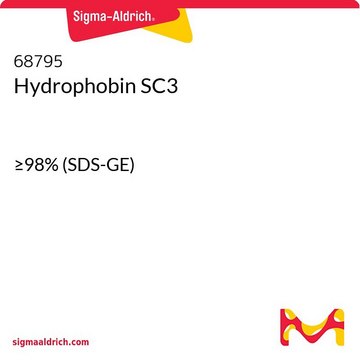81242
Poli(etilenoglicol)
tested according to Ph. Eur., 4,000
Sinônimo(s):
PEG
Faça loginpara ver os preços organizacionais e de contrato
About This Item
Fórmula linear:
H(OCH2CH2)nOH
Número CAS:
Número MDL:
Código UNSPSC:
12352104
ID de substância PubChem:
NACRES:
NA.21
Produtos recomendados
Agency
tested according to Ph. Eur.
Nível de qualidade
forma
solid
peso molecular
3500-4500
aplicação(ões)
pharmaceutical (small molecule)
cadeia de caracteres SMILES
C(CO)O
InChI
1S/C2H6O2/c3-1-2-4/h3-4H,1-2H2
chave InChI
LYCAIKOWRPUZTN-UHFFFAOYSA-N
Procurando produtos similares? Visita Guia de comparação de produtos
Categorias relacionadas
Descrição geral
Poly(ethylene glycol) (PEG) is a non-toxic water-soluble polymer. PEG term is used for the polymer chains with molecular weights below 20 000, while poly(ethylene oxide) (PEO) refers to the higher molecular weight polymers. PEG has various biomedical applications. It forms complexes with α-cyclodextrins. Engineering of PEG hydrogel particles by mesoporous silica (MS) templating method has been reported.
Aplicação
Poly(ethylene glycol) may be used in the following studies:
- For the modification of proteins to form the conjugates having increased circulating life and reduced immunogenicity and antigenicity.
- Preparation of hydrogels useful for the diffusion controlled delivery of proteins.
- Preparation of poly(ethylene glycol) dimethacrylate (PEGDM).
Código de classe de armazenamento
11 - Combustible Solids
Classe de risco de água (WGK)
WGK 1
Ponto de fulgor (°F)
Not applicable
Ponto de fulgor (°C)
Not applicable
Equipamento de proteção individual
Eyeshields, Gloves, type N95 (US)
Escolha uma das versões mais recentes:
Já possui este produto?
Encontre a documentação dos produtos que você adquiriu recentemente na biblioteca de documentos.
Os clientes também visualizaram
The clinical efficacy of poly (ethylene glycol)-modified proteins.
Fuertges F and Abuchowski A.
Journal of Controlled Release : Official Journal of the Controlled Release Society, 11(1), 139-148 (1990)
N A Peppas et al.
Journal of controlled release : official journal of the Controlled Release Society, 62(1-2), 81-87 (1999-10-16)
The use of hydrogels as carriers for protein delivery has been a subject of significant recent research. In our recent work, we have shown that diffusion controlled delivery of proteins from hydrogels containing poly(ethylene glycol) (PEG) can be possible and
Stephanie J Bryant et al.
Annals of biomedical engineering, 32(3), 407-417 (2004-04-21)
In approaches to tissue engineer articular cartilage, an important consideration for in situ forming cell carriers is the impact of mechanical loading on the cell composite structure and function. Photopolymerized hydrogel scaffolds based on poly(ethylene glycol) (PEG) may be synthesized
Complex formation between poly (ethylene glycol) and α-cyclodextrin.
Harada A and Kamachi M.
Macromolecules, 23(10), 2821-2823 (1990)
Idalis Villanueva et al.
Acta biomaterialia, 5(8), 2832-2846 (2009-06-11)
The pericellular matrix (PCM) surrounding chondrocytes is thought to play an important role in transmitting biochemical and biomechanical signals to the cells, which regulates many cellular functions including tissue homeostasis. To better understand chondrocytes interactions with their PCM, three-dimensional poly(ethylene
Nossa equipe de cientistas tem experiência em todas as áreas de pesquisa, incluindo Life Sciences, ciência de materiais, síntese química, cromatografia, química analítica e muitas outras.
Entre em contato com a assistência técnica


